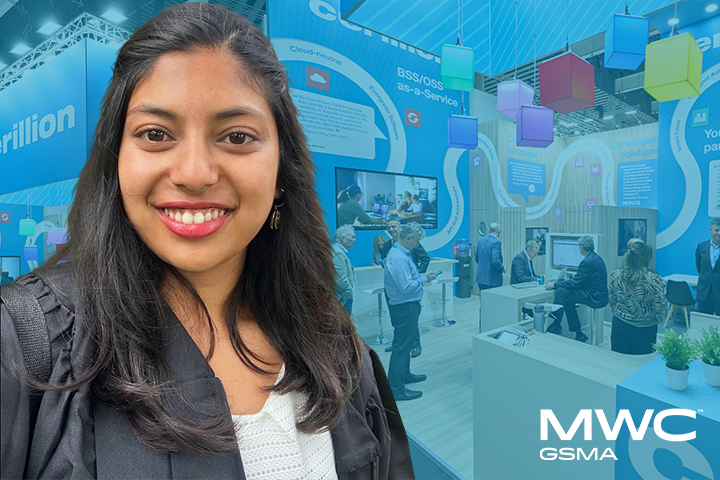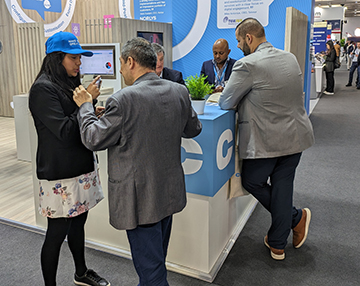Interview: Tafsia Shikdar on first impressions of MWC24

Cerillion has been attending MWC for well over 20 years now – so long in fact, we’ve forgotten what the experience can be like for a newcomer to the world’s biggest annual telecoms trade show. We asked Tafsia Shikdar, Presales Consultant at Cerillion, for the verdict on her first MWC.
Hi Tafsia – tell us a bit about yourself and what you do at Cerillion.
I'm a Presales Consultant within the sales team at Cerillion.
My background is in biomaterials, with some work in data science, as well as some experience within education, so this is my first venture into sales and the telco space, as well as my first time at MWC.
What were your first impressions of the show?

I expected it to be big, but it definitely surpassed my expectations. In fact, the latest figures from the GSMA confirm there were over 100,000 people there!
The booths themselves were colourful and impressive. I got lost in the maze that was Huawei’s stand – they had an entire section of security gates, forcing me to backtrack and walk all the way around – and my feet were sore from walking 20 minutes each way, back and forth across the show…not very friendly at all!
I was also surprised by the breadth and depth of topics covered, with a whole area for start-ups who weren't strictly mobile / telco related.
What key industry topics and trends did you pick up on?
AI was definitely the biggest buzzword – many people were surprised that we didn't have it emblazoned across our booth like so many others, given the impressive integrated GenAI capabilities we were demoing at the show.
As we explained to our many stand visitors, our approach is innovative, but cautious; being entrusted with mission-critical infrastructure and sensitive data, security is the main concern among all our customers. Exposing private data to open LLMs is not acceptable, while anonymised data tends to lose its richness. It is an area in which Cerillion is determined to make careful progress, whilst many legal and regulatory questions still remain, which is why our GenAI use cases are currently all focused on improving processes that do not involve personal data.
What we’re doing with AI is cutting-edge in the areas of catalogue management, fulfilment and intelligent process automation. Cerillion prides itself on being innovative whilst still providing the certainty of outcome our customers need; we’ve seen plenty of competitors burn out with quick investment into short-lived trends. As we’re customer-driven, the demand we see from our actual customers and prospects is what is pushing forward our GenAI roll-out, and I believe we’ll only see this continue to grow.
Smart cities and 5G Standalone were other big topics at the show, and ones which Cerillion can pride itself on being at the forefront of, given our real-world experience of implementing BSS/OSS solutions for these technologies alongside our customers.
Finally, there were many cool AR/VR and robotic technologies on display – the use cases I saw were mostly unrelated to telco, except for some automatic phone pricing machines, but I’m sure someone out there is trying.
So what technologies did you see that impressed you the most?
I liked the AR glasses by Mojie – trying them on made me think how in a few years, everyone will potentially be wearing Bluetooth glasses connected to their phone, replacing headphones, and taking hands-free to the next level. I see this as a trend that will probably be taken up by the average consumer, as opposed to Meta's Ray-Ban smart glasses, which will appeal more to people who like daily vlogging, in my opinion.
I was also a big fan of the realistic rubber-faced robot at the Etisalat stand:
Es un robot de inteligencia artificial presentado en el Mobile World Congress. #MWC2024 #IA #AI #robot #inteligenciaarticial #mwc #barcelona #blockchain #technologia #TransformaciónDigital pic.twitter.com/liT67TpSnb
— getAiTsolution (@getaitsolution) March 4, 2024
With all the facial technology and mechanical ability of the robots exhibited at the show, and of course the advent of realistic GenAI, it reminded me of the film I, Robot that I grew up with – hopefully without the conscious, blood-thirsty androids…
And finally, what are your key takeaways from your first MWC?
The future is here!
But also, how so many technologies can be prototyped and exhibited to generate hype, yet we don't ever see commercial versions of these technologies – even lower-quality ones – made available for consumers.
In my opinion, this showcases how fancy gimmicks often hide the true limitations of technology, and the burdens and costs of real-world roll-out. As a scientist, this frustrates me – I believe that innovation is propelled by open collaboration among great minds, yet progress nowadays is often hidden behind walls, where scientists and engineers might all be working on the same thing independently. This increases the time taken to launch these innovations, as everyone is fighting to patent it first, so it's all kept tight-lipped. This often means that technology won't be released until it is perfect, as no one wants their ideas taken and immediately improved and iterated on by someone else.
I hope we can move forward into more optimised ways of working and economic systems that foster open collaboration and extract value from pushing technology and society forward, instead of trying to build monopolies.
